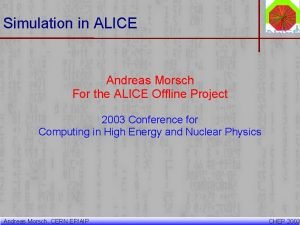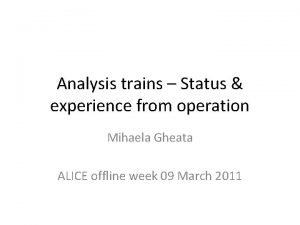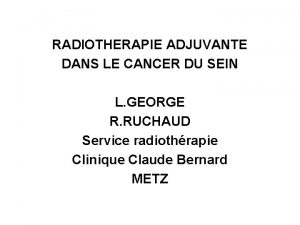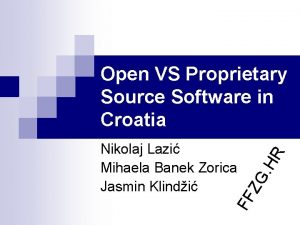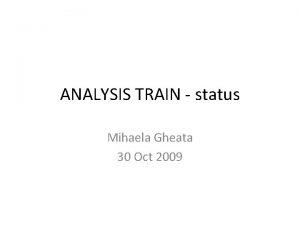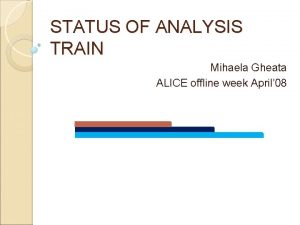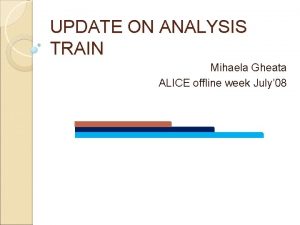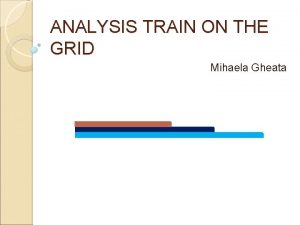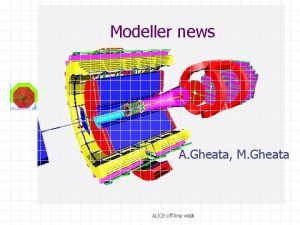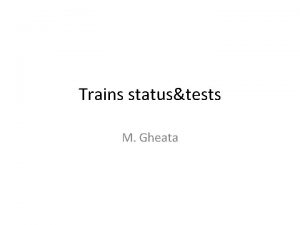Analysis trains Status experience from operation Mihaela Gheata









- Slides: 9

Analysis trains – Status & experience from operation Mihaela Gheata

Summary of central trains – QA(1) • PWG 1 QA train (PWG 1/Pilot. Analysis/Pilot. Train*. C) – 2 utility tasks (CDB connect + physics selection) – 20 user tasks, evolving very fast (2 new introduced the last month) – 28 wagons, below 2 GB resident memory (but close), output size below 30 MB • QA runs automatically for each run after reconstruction but was started on demand for different simulation productions – The default QA train is replaced when a new AN tag is deployed (weekly). All new data is processed by it. Train are indexed to avoid clashes. – We will run simulation QA automatically from now on.

Summary of central trains – QA(2) • The output of QA trains is stored in the Ali. En paths: /alice/data/2010/LHC 10 d/<run#>/ESDs/pass. N/QA<NN> – Output files: QAresults. root, event_stat. root, trending. root – The same run can be processed by several QA trains • On request, if new code was added to QA • Due to bugs or instabilities • Generally the last for a given run is the best • The train is quite big (close to the 2 GB limit) so we may need to limit in future the number of histograms – The output size per task is already limited to 50 MB, but there are many tasks and the number only increases – Now QA running stable but has to be closely followed for each new tag. – Some wagons (TPC, TRD, vertexing) are very important and the QA train cannot run without (otherwise need to be redone) • Some runs with large number of events produce memory problems during merging – Sometimes well beyond the accepted limits

The train type can be selected Terminate is run after task merging, producing event_stat. root and trending. root (only TPC currently) One can check which runs were processed by a given QA train

FILTERING trains • Producing centrally main AODs and delta AODs for data and MC productions – Currently vertexing AOD, muon/dimuon filters, dielectron filter and centrality filter • Three types so far: – FILTERmuon – produces Ali. AOD. root, Ali. AOD. Muons. root and Ali. AOD. Dimuons. root (no TENDER) • Started to run automatically after pass 1 • Ali. AOD. root also registered (!) – FILTERpass 1(2) – produces in addition Ali. AOD. Vertexing. HF. root and Ali. AOD. Dielectrons. root (uses TENDER for pass 1) and Ali. AODCentrality. root – FILTERsim – runs filtering for simulated data • • The process was not fully automatic so far due to the need of tenders with special configurations for pass 1, special requests (conferences , …) or bugs No merging done (memory problems in the past), so far the AOD size is chosen via Split. Max. Input. File. Number (which limits also execution time and memory use) – We will retry to merge AODs to see the limits


Production cycle • An analysis branch is created at the beginning of the week • Several tests are done via the alien handler for all types of trains – A tag is produced quite fast if OK – Reports posted in Savannah, fixes included in the branch • Not working wagons are excluded if the fixes come too late AND if the failing task is not among the critical ones. All QA trains missing these wagons (Vertexing, TPC, TRD) have to be redone. • The AN tag is produced at the end of the week and the default trains are replaced in LPM • New wagons are included only after extended tests (including memory profiling)

Central PWGn analysis trains • The central analysis train was maintained in the development phase centrally, but the effort was taken over by PWG groups – Needed since the number of tasks is growing too fast to be handled centrally • We discussed in the offline team the possibility to run PWG analysis trains centrally, for more efficiency, stability, availability of results and monitoring. – For all these reasons it is preferable to use the same procedures as for the current production trains (production cycle, reporting bugs, monitoring and registering results) – These trains should still be maintained by PWG groups, with full support from the central team – Using libraries, but par files could be still used at small scale to check the trunk if needed. – We will run this preferably on AODs • We will describe the requirements (most already known) to the persons responsible and provide all support needed to put these trains in place – The long term maintenance will be in the hands of PWGn groups

Summary • We have now more experience from several categories of trains which run centrally – Development and production have to work together, now we are using clear procedures to keep this under control • Results are made available to the collaboration – PWG 1 QA train results are now essential for checking run quality and finding problems in reconstruction – Most (almost all) data and recent MC productions have AODs • No excuse not to use them in analysis • We will organize analysis trains that will be integrated with the central tools for production – Managed by PWG groups

